Closing Bell: An Exhibition About the Landmarks Law in Brooklyn and Beyond
Fifty years ago last month the city passed the Landmarks Law — and if it hadn’t we’d be living in a very different place today. That’s the premise behind “Saving Place: 50 Years of New York City Landmarks,” an exhibition currently running at the Museum of the City of New York. The exhibit, which opened…
Fifty years ago last month the city passed the Landmarks Law — and if it hadn’t we’d be living in a very different place today.
That’s the premise behind “Saving Place: 50 Years of New York City Landmarks,” an exhibition currently running at the Museum of the City of New York. The exhibit, which opened last month, looks at the growth of the preservation movement, the roots of the pioneering law, its evolution and its impact on the city.
There’s plenty there relating to Brooklyn, including a section on the role of Brooklyn Heights in creating the law. Visitors will find images of many Brooklyn buildings, including the demolished Brooklyn Savings Bank, the new skating rink in Prospect Park, and the Renaissance and Alhambra apartments in Bedford Stuyvesant (which were converted into affordable housing). Also featured are additions to the Pratt architecture school, Park Slope’s Poly Prep and the Jehovah’s Witness library in Brooklyn Heights.
The Landmarks Law has proved to be “an engine of New York’s growth and success,” the curators assert, and Brooklyn has played an important role.
“One could not possibly do an exhibition about landmarks in New York City without covering Brooklyn,” Andrew Dolkart, co-curator of the exhibition and director of Columbia University’s Historic Preservation Program, told us.
Above, Mayor Robert Wagner signs the Landmarks Law in 1965. The exhibit runs through Sept. 13.
All photos via Museum of the City of New York; photo of Washington Street below by Iwan Baan via the Museum of the City of New York
Above, Washington Street in Dumbo, part of the Dumbo Historic District.
Above, a pair of Gothic style brownstones at 131 and 135 Hicks Street in Brooklyn Heights.












What's Your Take? Leave a Comment